
Last Updated on
Dawn breaks over Papke Hill at Camp Bullis, Texas as a row of cadets take the line for a new day of training. A cadre of professional shotists with law enforcement, military and competitive shooting backgrounds stand ready to lead and assist the soon-to-be cops through a variety of exercises teaching street survival with a handgun. This is the week-long firearms portion of Basic Patrol Officer Course offered by the Alamo Area Regional Law Enforcement Academy.
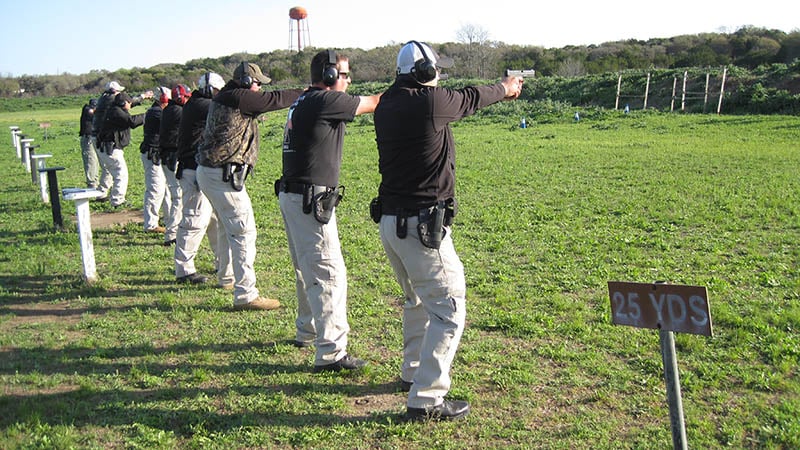
History
The current approach to policing is based on a reactive strategy focusing on responding to calls for service and was first established in the 1920s when Berkeley, California police chief August Vollmer professionalized his force, adopted new technologies and emphasized officer training. Since then all the states in the Union have adopted this model and have formed organizations instituting minimum standards for this training, allowing individual agencies freedom within their own programs provided these minimums are met. The goal of AARLEA is to provide innovative and comprehensive law enforcement education, seeking to impact the skills and attitudes of current and future law enforcement practitioners and leaders. Headquartered in San Antonio, the Academy is recognized as a pioneering agency in the region for the delivery of law enforcement training. As a part of the Alamo Area Council Of Governments (AACOG), which constitutes a voluntary association of local governments, the Academy provides training for twelve counties that comprise the Alamo Area planning region.
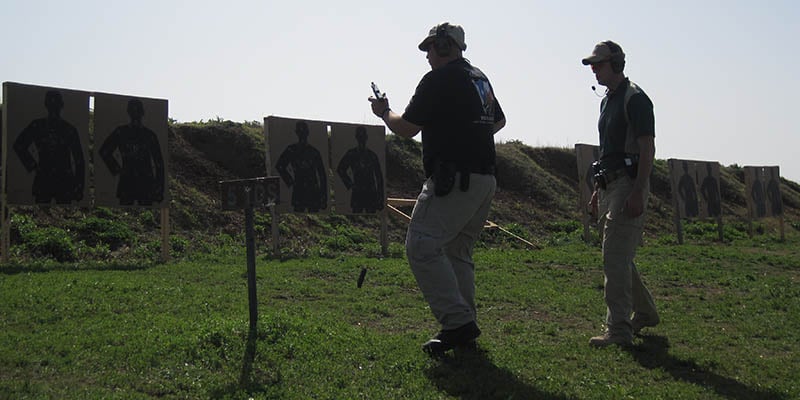
TCLEOSE establishes standards for law enforcement training throughout the republic of Texas based on Texas Administrative Code. AACOG instructors make a point to exceed these standards in all of their courses. For example, TCLEOSE mandates for handgun qualification a minimum 50 round scored course of fire which includes shooting at least five rounds of duty ammunition fired at ranges from point-blank to at least 15 yards, with at least 20 rounds at or beyond seven yards and at least one timed reload. AACOG’s basic handgun qualification requires students to shoot five rounds for record with duty ammo at 25 yards and has several strings with reloads on the clock.

Classes For Officers
As with most progressive law enforcement training organizations AACOG offers a variety of courses. Starting with the most basic are Police Handgun Fundamentals and Department Firearms Qualification. The first is a one day review of handgun marksmanship and handling skills especially useful for officers from smaller departments lacking any internal training support. AACOG also runs standardized TCLEOSE-recognized courses for officers needing a mandatory qualification.
Much of AACOG’s firearms training effort focuses on conducting the Basic Patrol Officer Course on a regular basis. This is a comprehensive introduction to the use of the defensive handgun and is a required component needed to graduate the Academy before taking a law enforcement position.

Long guns are also a component of modern policing. AACOG offers Patrol Rifle Operator, Shotgun Operator and Precision Rifle classes to support this need. Patrol Rifle covers the use of typical self-loading long guns and begins with group shooting and zeroing at 50 yards to teach basic slow fire fundamentals. This is confirmed at 200 yards. Next, basic ballistics are covered and reinforced with live fire exercises to teach the offset between line of sight and point of impact at various ranges. From there tactical movement is covered, such as pivots, moving to position, shooting on the move, and snap shooting from ready positions. Many of these drills are done on steel to give positive instant recognition of good shooting. Target discrimination, engaging specific, called targets on the clock and transition to sidearm is covered. Shotgun Operator is similar, adding the effects of various types of shot, zeroing slugs, select round drills to switch ammo types.
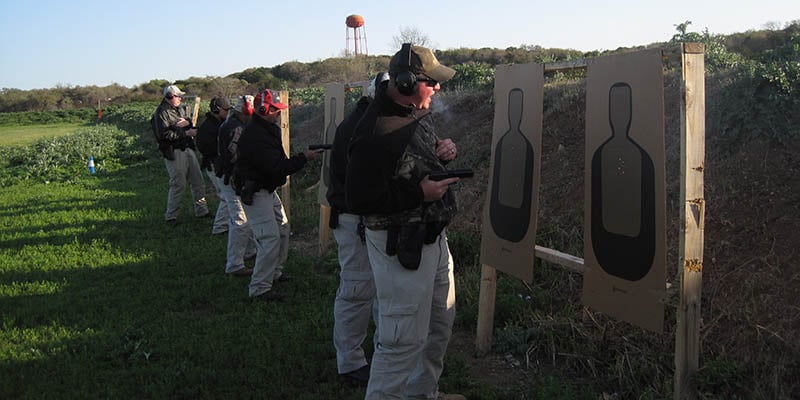
Precision Rifles aren’t typically found in individual patrol cars but many agencies have them available and select personnel will need to be trained in their effective use. Fundamentals of precision marksmanship, measuring angular deviation, ballistics for long range and precision engagements and shot placement on real world, 3D targets starts the course off. Field exercises include position shooting on a Known Distance range range estimation, environmental and wind considerations and angle firing. Because of the nature of precision rifle law enforcement engagements, stress fire and shoot/no-shoot engagements are emphasized. In these situations the nature and time of the shoot are controlled by the target and the rifleman has to react as things evolve.
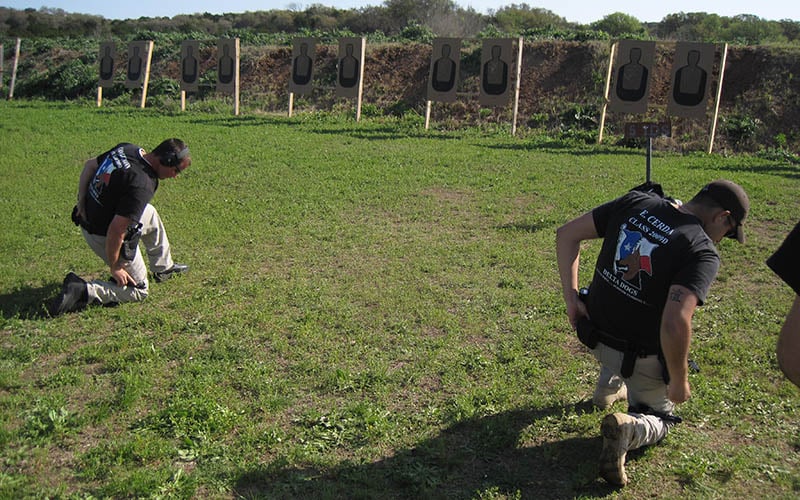
AACOG Approach
Like all well-run firearms training courses, AACOG begins with an emphasis on slow fire fundamentals. Before beginning any type of fast or tactical shooting, students conduct handgun group shooting with dummy rounds out to 25 yards on paper. Speed and complexity is added gradually. The Academy breaks their instruction periods into classroom, static range/qualification, dynamic range (movement), and force-on-force sessions. Fundamentals begin with the stance, where students are taught to use a non-threatening interview position as their platform. Shooting from a solid, two-handed, modified isosceles, eye-level position is encouraged as most effective for most engagements and point shooting only done from compressed guard, or retention, position at contact distances.
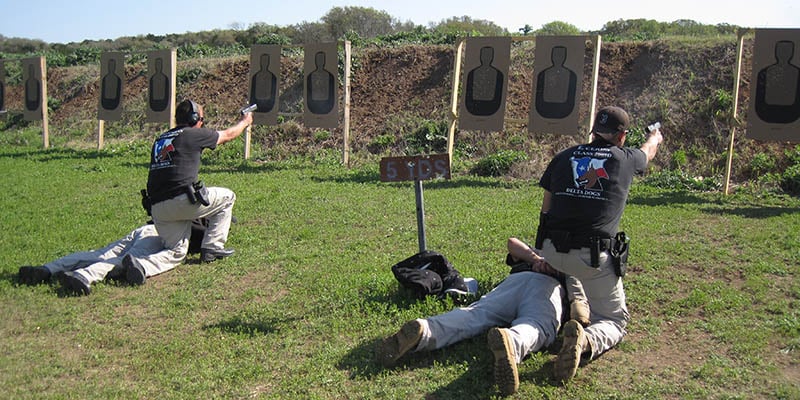
With the exception of slow fire group shooting, all strings are timed and begin from the compressed guard or holster and presented to the target. At contact distance (inside double arm’s length) the handgun remains at compressed guard for retention purposes. As the distance increases out to ten yards or so, students are taught to use a front sight flash sight picture. As long as the front sight is somewhere near target center the shot will likely be good enough. This has been called “shooting out of the notch” by some trainers. The idea is that the officer should always try to find some kind of visual cue to ensure alignment but inside ten yards a perfect front sight-rear sight relationship isn’t required to get reasonably solid torso hits. Beyond a dozen yards distance, traditional sight alignment is sought with a hard front sight focus. While AACOG instructors are versed in point shooting methods and explore a variety of techniques, they have found this approach to be most consistent for best results.
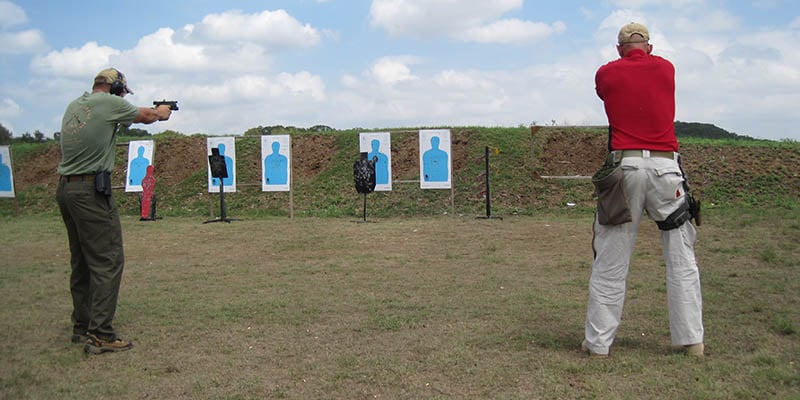
Trigger control is trained with instructor and peer coach hands-on exercises. Sometimes called the “Exemplar Drill” and known as “Trigger Drills” in the LAPD, students grip and aim their handgun while a coach presses the trigger. This helps the student see the effects of their grip and aim while removing trigger control from the equation. Its also a great way to instill proper technique. Rather than explain that smooth pressure is best, they demonstrate it hands-on. Shot follow through exercises constitute a number factors. For pure marksmanship this is developed by calling shots, testing if the shooter is seeing the sights during recoil. For speed, trigger reset allows good control at higher speeds. There is also the post-shooting follow through of after action drills, threat scans to open up tunnel vision, issuing verbal commands and maintain professional police communication.

These fundamentals serve as the foundation as students move to the dynamic range exercises. Gun handling, reducing stoppages, moving and shooting, and moving to and around cover are covered. One drill, Rolling Thunder, has a team of students engaging targets in sequence on command. As the team completes this, the tail man calls “Clear!” and the lead man maneuvers to a new position. Without pause, the roles are changed and a new sequence begins. This requires officers to safely maneuver around each other with loaded firearms while shooting under time pressure. The dynamic range exercises culminate with a night shoot fired in a sealed indoor range with zero ambient light.
Instructor Development
A good mark of any shooting program is that the cadre are diverse and willing to explore alternative methods. Wise leaders of high speed military units will send personnel to schools and events outside of the Department of Defense to find methods that differ from current doctrine. AACOG instructors have a diverse background, ranging from a variety of Law Enforcement experience, military and competition shooting. What’s more, AACOG’s firearms staff are all adjunct instructors and have regular law enforcement and military positions outside the Academy. They also seek out additional training, including methods that conflict with the Academy’s own doctrine to see if there is a better way to do things. While AACOG meticulously adheres to TCLEOSE requirements, the Academy continually adds to its best practices.
If you’ve been through any thoughtful firearms training, law enforcement or otherwise, much of this should sound familiar. AACOG’s Academy certainly isn’t innovating training by their approach, they are sticking with proven solid methods that are known to work while remaining open-minded to new ideas.




Leave a Reply